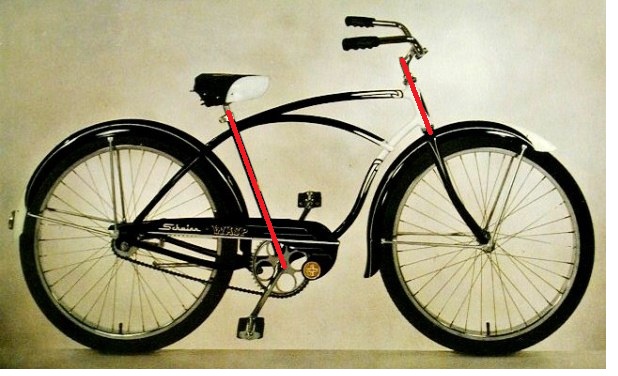Bicycle frame geometry is a complicated topic with lots of numbers, opinions, and passion.
Frame geometry affects 1. how a bicycle feels/handles and 2. how a bicycle will fit. Frame geometry is something you can see and it is something you can feel.
It's best to describe bicycle frame characteristics using words like "stable", "unstable", "agile", "fast steering", "slow steering", "stable with a load" etc. rather than value judgement words like "good" or "bad".
One might describe a frame by its use - touring bike, racing bike - the challenge with this is that there is a range of designs inside each category.
It is possible to look at a frame and guess at how it will ride or fit. For example, wheelbase, head tube angle and seat tube angle are easy to see once you've developed a mental reference for the characteristics of frame geometry. Guessing is nice as a rule of thumb but to really know a bike you have to ride it.
Frame design - like most things on a bicycle - is all about compromise. As one example, for road bikes, at one extreme there touring bikes that are usually smooth riding, comfortable and stable under heavy loads. At the other extreme is the nimble racing bike. Bikes that fall into the middle - sport bikes - compromise on the two extremes in different ways that are determined by the design goals.
Here is a drawing illustrating the different measurements involved in frame geometry.

www.cyclingabout.com - Understanding Bicycle Frame Geometry
Just to get you started here is a touring bike and a racing bike with one easy to recognize characteristic highlighted.
Touring bike.
Ignore the racks. You can hang racks on almost anything if you really want to.

Visually it's easy to pick out the wheelbase length - especially if the wheel size of the two bikes is the same. Longer wheelbase bikes tend to have the rear wheel further away from the seat tube. For a 48 cm size frame this bike has a 104.1 cm wheelbase. Complete frame specs are at the link.
Trek 520
Racing bike.
 A shorter wheelbase usually means that the rear wheel is closer to the seat tube. For a 48 cm size frame this bike has a 97.2 cm wheelbase. Complete frame specs are at the link.
A shorter wheelbase usually means that the rear wheel is closer to the seat tube. For a 48 cm size frame this bike has a 97.2 cm wheelbase. Complete frame specs are at the link.
2023 Trek Madone SLR Gen 7
Here are two more measurements to think about. Seat tube angle and head tube angle.

Compare the seat tube and head tube angle on this bike with the two bikes above.
Think about how seat tube angle affects fit. On the racing and touring bike your body will be positioned more vertically over the crank. The Schwinn angle gives a more upright riding position.
The Schwinn bike has what is referred to as a "slack" at about 68 degrees. The touring and racing bikes have a "steeper" angle than the Schwinn at about 74 degrees.
Seat tube angle affects seated rider weight distribution. The further back the rider sits the more weight is on the rear wheel.

bikeinsights.com
Notice in this chart that seat tube angle has a range for each category. For example, Triathlon seat tube angles range from 75 to 80 degrees.
Seat tube angle also affects handling. I knew a guy who was comfortable hauling 75 pounds of newspapers on the back of his Schwinn like this and 25 pounds on the front rack. The bike handled and turned like a slug even when not loaded but it was wonderful for its task.
Head Tube Angle
bikeinsights.com
Head tube angle plays a significant role in how a bike handles. In
general a steep head tube angle results in quicker-feeling steering
while a shallow angle results in more stable straight-line tracking.
However, this is a generalization and the Fork Offset, Wheel Diameter,
and Tire Width are all factors at play
Traditionally, performance road bikes have had steeper head tubes
while recreational and utility road bikes have more moderate angles.
Mountain bikes are commonly more slack than road bikes and have a
greater range of angles depending on the use case.
The head tube angle on the Trek 520 is 70 degrees, the Madone is at 72 degrees, the Schwinn is approximately 68 degrees
This is a complicated topic and I've focused on a simplified explanation of just three characteristics. No one (or two) metric will tell you everything. To gain more understanding I recommend reading articles on the subject -some examples are linked in this answer - this will help you learn the vocabulary and what some of the controversies are.
On top of what is measurable - frame angles, wheelbase, etc. there is personal preference.
- How does it feel to you?
- What do you like?
- What will fit your body best?
There is also what works for a particular task. Bikes are kind of like shoes. We have hiking shoes, running shoes, court shoes, etc. Just like many people have more than one kind of shoe there is a tendency to have more than one bike for different for tasks.
Riding different bikes and developing an understanding of what works for you will help you get the best tool for your needs. Otherwise, you are reading numbers and trusting someone else to tell you what will work.






